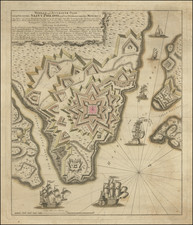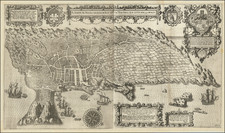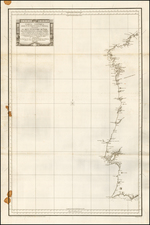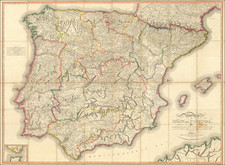Fine birds-eye view of the island of Terceira and the town of Angra, based upon Baptista van Deutecum's view of the Island, which appeared in LInschoten's Itinerario.
Linschoten's view of Terceira in the Azores is one of the most decorative and recognizable birdseye views engraved in the 16th Century. Linschoten served 6 years as the bookkeeper for the Archbishop of Goa (1583-89). While in Goa, as a result of his position, Linschoten had access to secret information, including the nautical maps that were well guarded for over a century. Misusing the trust in him, he began meticulously copying these maps. In 1587, the Archbishop of Goa died while on a trip to Lisbon to report to the King of Portugal, ending Linschoten's stay in Goa. He set sail for Lisbon in January, 1589, passing by the Portuguese supply depot at St. Helena island in May 1589.
Linschoten was "one of the pathfinders for the first Dutch voyages to the East" (Schilder, p. 195). He was in the service of the Portuguese as Secretary to the Portuguese Archbishop of Goa in India from 1583 to 1589. Here, he had access to many Portuguese portolans as well as other valuable commercial information, especially as Goa at this time was the commercial and political center for the Portugal Empire in the East. Van Linschoten left Goa for home in January 1589. On the way to Portugal, his ship was pursued by an English fleet and lost its cargo in a storm while anchored off the Azores. After the loss of the cargo, Van Linschoten was persuaded to stay and help recover it; he spent two years on Tercera, working and preparing his notes from Goa. Van Linschoten eventually arrived in Lisbon early in 1592, and then sailed home to The Netherlands. His account of his experiences is one of the most important travel works of the period.
Angra do Heroísmo is the principal city of the Island of Terceira, the major port and trading town in the islands. Terceira became the principal port of In 1583, Philip II of Spain, as king of Portugal, sent his fleet to clear the Azores of a combined multinational force of adventurers, mercenaries, volunteers and soldiers who were attempting to establish the Azores as a staging post for a rival pretender to the Portuguese throne. Following the success of his fleet at the Battle of Ponta Delgada, the captured enemy were hanged from yardarms, as they were considered pirates by Philip II. (This was added to the "Black Legend" by his enemies.) An English expedition against the Azores in 1597, the Islands Voyage, also failed. Spain held the Azores in what is called The Babylonian captivity of 1580-1642.
Mathaus Merian (1593-1650) was the father of engraver Matthäus the Younger, and of the painter, engraver, and naturalist Maria Sibylla Merian. He was born in Basel, Switzerland and trained in engraving in Zurich. After a time in Nancy, Paris and Strasbourg, he settled in Frankfurt. While there, he worked for Johann Theodor de Bry, the publisher and son of the travel writer. In 1617, he married Maria Magdalena de Bry, Johann Theodor’s daughter. In 1623, Merian took over the de Bry publishing house upon the death of his father-in-law. Merian’s best known works are detailed town views which, due to their accuracy and artistry, form a valuable record of European urban life in the first half of the sixteenth century









![[Minorca] Plan de la Ville et du Port Mahon et du Fort Philippe Tel qu'il etoit Fortifie en 1706 par les Espagnols](https://storage.googleapis.com/raremaps/img/small/36450.jpg)




![Atlantic Islands [Azores, Madeira, Canary and Cape Verde]](https://storage.googleapis.com/raremaps/img/small/94761.jpg)